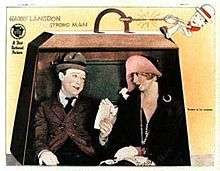The Strong Man
| The Strong Man | |
|---|---|
 Theatrical poster | |
| Directed by | Frank Capra |
| Produced by | Harry Langdon |
| Written by | Arthur Ripley |
| Starring |
Harry Langdon Priscilla Bonner |
| Music by |
Carl Davis (1985) (orchestration: Kevin Townend) |
| Cinematography |
Glenn Kershner Elgin Lessley |
| Edited by |
Harold Young Arthur Ripley |
Production company |
Harry Langdon Corporation |
| Distributed by |
First National Pictures Kino Video (Home video release) |
Release dates |
|
Running time | 75 minutes |
| Country | United States |
| Language |
Silent film English intertitles |
The Strong Man is a 1926 American comedy silent film starring Harry Langdon and directed by Frank Capra in his feature-length directorial debut.[1]
Along with Tramp, Tramp, Tramp, The Strong Man is Langdon's best known film. Capra would also direct Langdon's next feature, Long Pants (1927), which would be their final collaboration.
Plot
Paul Bergot (Harry Langdon) is a Belgian immigrant to the United States who has fallen in love with Mary Brown (Priscilla Bonner), a blind woman. They met as pen-pals when he was fighting in Europe during World War I. Mary even sent Paul a photo of her.
Paul searches for Mary Brown by asking every woman he meets if she is Mary Brown. By accident he rescues her town from crooks and bootleggers.
Cast
- Harry Langdon as Paul Bergot
- Priscilla Bonner as Mary Brown
- Gertrude Astor as Lily of Broadway
- William V. Mong as Holy Joe
- Robert McKim as Mike McDevitt
- Arthur Thalasso as Zandow the Great
Reception
Critical response
The staff at Variety magazine liked the film and wrote, "A whale of a comedy production that has a wealth of slapstick, a rough-and-tumble finish and in the earlier passages bits of pantomimic comedy that are notable. Harry Langdon has a comic method distinct from other film fun makers. The quality of pathos enters into it more fully than the style of any other comedian with the possible exception of Chaplin. His gift of legitimate comedy here has a splendid vehicle."[2]
More recently, critic Maria Schneider reviewed Langdon's work and wrote, "Not surprisingly, Langdon was most often cast as an oblivious innocent adrift in a corrupt world, a formula that made him terrifically popular in the mid-1920s. Of the three features Kino has released, The Strong Man (1926) is the best...Crisply timed and almost perfectly paced, it is also notable as Frank Capra's directorial debut."[3]
Critic Richard von Busack wrote, "A little tragedy and a lot of laughs can be seen in 1926's The Strong Man... Later, on the crowded bus out west, Langdon demonstrates a sterling silent comedy bit: the one about the goof who mistakes a jar of stenchy Limburger cheese for Vicks' VapoRub. With exquisite deadpan, Langdon keeps the incident from being too sad; he deftly, repeatedly, sucker-punches a bully who protests against the smell. Director Frank Capra's energy and sturdy plot sense counterpoint Langdon's wonderful strangeness."[4]
Reviewing Langdon's career and movies, silent film critic and author Dan Navarro wrote, "When Harry Langdon's Tramp, Tramp, Tramp premiered in March 1926, it was greeted by moviegoers as a worthy challenger to the great films of Charles Chaplin, Buster Keaton, and Harold Lloyd. Langdon was hailed as 'the fourth comedy genius.' That heady feeling was reinforced when, in September 1926, Langdon appeared in an even better picture, Frank Capra's The Strong Man...[the film] was Frank Capra's first directorial effort, and his genius shines through."[5]
Awards
In 2007, The Strong Man was selected for preservation in the United States National Film Registry by the Library of Congress as being "culturally, historically, or aesthetically significant."
See also
References
- ↑ The Strong Man at the Internet Movie Database.
- ↑ Variety. Film review, 1926. Last accessed: February 18, 2008.
- ↑ Schneider, Maria. AV Club, DVD/film review, March 29, 2002. Last accessed: February 18, 2008.
- ↑ von Busack, Richard. MetroActive, film review, November 28, 2007. Last accessed: February 18, 2008.
- ↑ Navarro, Dan. Dan Navarro's Silent Film Guides, 2006. Last accessed: February 18, 2008.
External links
- The Strong Man at the American Film Institute Catalog
- The Strong Man at the Internet Movie Database
- The Strong Man at AllMovie
- The Strong Man at the TCM Movie Database
- Harry Langdon article at Images Journal by Gary Johnson
- The Strong Man complete film on YouTube